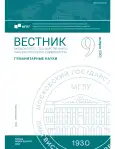PATTERNS OF FORMATION OF BASIC VALUES (BASED ON THE MATERIAL OF ANCIENT CHINESE LINGUOCULTURE)
- Authors: Dubkova O.V.1
-
Affiliations:
- Xi’an International Studies University, Xi’an, China Nizhny Novgorod Linguistic University, Nizhny Novgorod, Russia
- Issue: No 9(890) (2024)
- Pages: 44-50
- Section: Linguistics
- URL: https://bakhtiniada.ru/2542-2197/article/view/297415
- ID: 297415
Cite item
Full Text
Abstract
The purpose of the article is a linguistic analysis of axiologeme words in ancient Chinese linguistic culture. The study is based on etymological, component and contextual analysis of lexicographic sources. The structure of hieroglyphs denoting ‘value’ contains graphemes that reflect ancient Chinese ideas about wealth: the presence of workers, land, tools and household items, houses, money, etc. Changing the structure of the hieroglyph-axiologeme leads to semantic shifts in lexical meaning from concrete to abstract. The modern understanding of ‘value’ in Chinese linguistic culture is based on ancient Chinese ideas reflected in the structure of hieroglyphs-axiologemes.
About the authors
Olga Vladimirovna Dubkova
Xi’an International Studies University, Xi’an, ChinaNizhny Novgorod Linguistic University, Nizhny Novgorod, Russia
Author for correspondence.
Email: linuan12@mail.ru
PhD (Philology), Professor Foreign Expert, Xi’an International Studies University; Associate Researcher of the Research Laboratory “Theoretical and Applied Problems of Translation Studies” of Nizhny Novgorod Linguistic University
ChinaReferences
- 郑晓江,钟向东.对中国传统价值观的思考[J].学术月刊,1986,18(3):14-17.= Zheng Xiaojiang, Zhong Xiangdong. (1986). Thoughts on traditional Chinese values. Academic Monthly, 18(3), 14–17. (In Chinese)
- 李明华.论中国传统价值观的形成和发展[J].社会科学家,1992,7(6):86-90.= Li Minghua (1992). On the Formation and Development of Traditional Chinese values. Social scientist, 7(6), 86–90. (In Chinese)
- 钱再见.人的现代化与中国传统价值观的现代转向[J].南京社会科学,2000(12):41–44.Qian Zaijian (2000). The modernization of people and the modern shift of traditional Chinese values. Nanjing Social Sciences, 12, 41–44. (In Chinese)
- 徐中舒著.甲骨文字典[M].成都:四川辞书出版社,2014.01.1613页.= Xu Zhongshu (2014). Palaeographic Dictionary. Chengdu: Sichuan Dictionary Publishing House. (In Chinese)
- 徐建中著.汉字国学 汉字里的国学常识[M].北京.中国商业出版社,2016.11.264页.= Xu Jianzhong. (2016). Chinese characters. Chinese studies. Common sense of Chinese studies in Chinese characters [M]. Beijing, China Business Press. (In Chinese)
- 许慎.说文解字[M].长春:吉林美术出版社,2015.03.= Xu Shen. (2015). Speak and interpret words. Chang-chun: Jilin Fine Arts Publishing House. (In Chinese)
- 李学勤编.字源[M].天津.天津古籍出版社.2013.07.1420页.= Li Xueqin (2013). Etymology (of a non-Chinese word). Tianjin: Tianjin Ancient Books Publishing House. (In Chinese)
- 现代汉语词典.商务印书馆,2022.1800页.= Modern Chinese Dictionary. (2022). Commercial Press. (In Chinese).
- Pishchalnikova, V. A. (2023). Prognosticheskij aspekt psiholingvisticheskogo issledovanija znachenija slova = Prognostic aspect of the psycholinguistic study of the meaning of the word. Vestnik of Moscow State Linguistic University. Humanities, 2(870), 49–56. 10.52070/2542-2197_2023_2_870_9. (In Russ.)
Supplementary files










